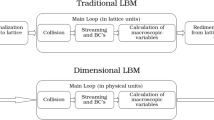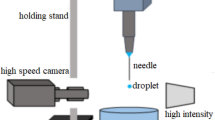Abstract
Understanding the dynamics of a water droplet after impacting on a moving wall is significant for many applications such as repelling rain droplets from a vehicle. In this paper, a water droplet impacting on a moving hydrophobic wall is studied numerically using a 3D lattice Boltzmann method (LBM). The accuracy of the present model is validated by comparing with existing correlation equations for the maximum spread factor and the contact time. It is found that the droplet spreads into an asymmetric shape after impacting on the moving wall owing to the momentum transfer from the wall to the droplet. The droplet deformation increases with the increasing of the wall velocity. Because of different bouncing behaviors of the droplet, the effect of the wall velocity on the droplet contact time varies with contact angles: the droplet contact time decreases with the increasing of the wall velocity for θ = 156°, while the droplet contact time increases with the increasing of the wall velocity for θ = 130°. It is also found that the droplet bouncing motion will be suppressed at a high wall velocity for θ = 130°. Finally, a map in terms of the Weber (We) number versus the contact angle (θ) is obtained, showing that a larger critical contact angle is required for droplet rebounding from a moving wall. This work provides a guidance that a moving wall needs to be more hydrophobic than a stationary wall to repel water droplets.
Graphical abstract














Similar content being viewed by others
References
Josserand, C., Thoroddsen, S.T.: Drop impact on a solid surface. Annu. Rev. Fluid. Mech. 48, 365–391 (2016)
Chen, L., Xiao, Z., Chan, P.C.H., Lee, Y., Li, Z.: A comparative study of droplet impact dynamics on a dual-scaled superhydrophobic surface and lotus leaf. Appl. Surf. Sci. 257, 8857–8863 (2011)
Li, X., Reinhoudt, D., Crego-Calama, M.: What do we need for a superhydrophobic surface? A review on the recent progress in the preparation of superhydrophobic surfaces. Chem. Soc. Rev. 36, 1350 (2007)
Khojasteh, D., Kazerooni, M., Salarian, S., Kamali, R.: Droplet impact on superhydrophobic surfaces: a review of recent developments. J. Ind. Eng. Chem. 42, 1–14 (2016)
Caviezel, D., Narayanan, C., Lakehal, D.: Adherence and bouncing of liquid droplets impacting on dry surfaces. Microfluid Nanofluid 5, 469–478 (2008)
Liu, Y., Whyman, G., Bormashenko, E., Hao, C., Wang, Z.: Controlling drop bouncing using surfaces with gradient features. Appl. Phys. Lett. 107, 51604 (2015)
Antonini, C., Villa, F., Bernagozzi, I., Amirfazli, A., Marengo, M.: Drop rebound after impact: the role of the receding contact angle. Langmuir 29, 16045–16050 (2013)
Liu, Y., Andrew, M., Li, J., Yeomans, J.M., Wang, Z.: Symmetry breaking in drop bouncing on curved surfaces. Nat. Commun. 6, 1–8 (2015)
Jung, Y.C., Bhushan, B.: Dynamic effects of bouncing water droplets on superhydrophobic surfaces. Langmuir 24, 6262–6269 (2008)
Li, X., Ma, X., Lan, Z.: Dynamic behavior of the water droplet impact on a textured hydrophobic/superhydrophobic surface: the effect of the remaining liquid film arising on the pillars’ tops on the contact time. Langmuir 26, 4831–4838 (2010)
Bange, P.G., Bhardwaj, R.: Computational study of bouncing and non-bouncing droplets impacting on superhydrophobic surfaces. Theor. Comp. Fluid Dyn. 30, 211–235 (2016)
Bird, J.C., Tsai, S.S.H., Stone, H.A.: Inclined to splash: triggering and inhibiting a splash with tangential velocity. New. J. Phys. 11, 63017 (2009)
Zen, T., Chou, F., Ma, J.: Ethanol drop impact on an inclined moving surface. Int. Commun. Heat Mass Transf. 37, 1025–1030 (2010)
Hao, J., Green, S.I.: Splash threshold of a droplet impacting a moving substrate. Phys. Fluids. 29, 12103 (2017)
Almohammadi, H., Amirfazli, A.: Understanding the drop impact on moving hydrophilic and hydrophobic surfaces. Soft Matter 13, 2040–2053 (2017)
Manservisi, S., Scardovelli, R.: A variational approach to the contact angle dynamics of spreading droplets. Comput. Fluid 38, 406–424 (2009)
Gupta, A., Kumar, R.: Two-dimensional lattice boltzmann model for droplet impingement and breakup in low density ratio liquids. Commun. Comput. Phys. 10, 767–784 (2011)
Zhang, D., Papadikis, K., Gu, S.: Three-dimensional multi-relaxation time lattice-boltzmann model for the drop impact on a dry surface at large density ratio. Int. J. Multiphas. Flow. 64, 11–18 (2014)
Xiong, W., Cheng, P.: 3D lattice boltzmann simulation for a saturated liquid droplet at low ohnesorge numbers impact and breakup on a solid surface surrounded by a saturated vapor. Comput. Fluids. 168, 130–143 (2018)
Yin, C., Wang, T., Che, Z., Jia, M., Sun, K.: Oblique impact of droplets on microstructured superhydrophobic surfaces. Int. J. Heat Mass. Transf. 123, 693–704 (2018)
Shen, C., Yu, C., Chen, Y.: Spreading dynamics of droplet on an inclined surface. Theor. Comp. Fluid. Dyn. 30, 237–252 (2016)
Raman, K.A.: Normal and oblique droplet impingement dynamics on moving dry walls. Phys. Rev. E. 99, 053108 (2019)
Scheller, B.L., Bousfield, D.W.: Newtonian drop impact with a solid surface. AIChE. J. 41, 1357–1367 (1995)
Pasandideh-Fard, M., Qiao, Y.M., Chandra, S., Mostaghimi, J.: Capillary effects during droplet impact on a solid surface. Phys. Fluids. 8, 650–659 (1996)
Richard, D., Clanet, C., Quéré, D.: Surface phenomena: contact time of a bouncing drop. Nature 417, 811 (2002)
Rayleigh, L.: On the capillary phenomena of jets. Proc. R. Soc. London 29, 71–97 (1879)
Joshi, A.S., Sun, Y.: Multiphase lattice Boltzmann method for particle suspensions. Phys. Rev. E. 79, 66703 (2009)
Shan, X., Chen, H.: Lattice boltzmann model for simulating flows with multiple phases and components. Phys. Rev. E. 47, 1815 (1993)
Xiong, W., Cheng, P., Quan, X., Yao, W.: Droplet impact on a layer of solid particles placed above a substrate: a 3D lattice Boltzmann study. Comput. Fluids 188, 18–30 (2019)
Wachters, L., Westerling, N.: The heat transfer from a hot wall to impinging water drops in the spheroidal state. Chem. Eng. Sci. 21, 1047–1056 (1966)
Stern, F., Wilson, R.V., Coleman, H.W., Paterson, E.G.: Comprehensive approach to verification and validation of cfd simulations—part 1: methodology and procedures. J. Fluid Eng. 123, 793–802 (2001)
Aboud, D.G.K., Kietzig, A.: Splashing threshold of oblique droplet impacts on surfaces of various wettability. Langmuir 31, 10100–10111 (2015)
Acknowledgements
This work is supported by the National Key Research and Development Program of China under number 2019YFB1703604.
Author information
Authors and Affiliations
Corresponding author
Additional information
Communicated by Vassilios Theofilis.
Publisher's Note
Springer Nature remains neutral with regard to jurisdictional claims in published maps and institutional affiliations.
Appendices
Appendix
Appendix. Determination of the static contact angle
The relationship between the fluid–solid interaction strength Gs and the contact angle θ can be determined by simulating a stationary droplet on the wall. Fig. 14 (a) shows the relationship between the fluid–solid interaction strength and the contact angle. The contact angle increases almost linearly with the fluid–solid interaction strength. Fig. 14 (b) shows equilibrium shapes of the droplet for the fluid–solid interaction strength Gs of −0.06, −0.08, and −0.10, corresponding to equilibrium contact angles of 156°, 140° and 130°, respectively.
Rights and permissions
About this article
Cite this article
Chao, C., Zhong, S. Numerical study of a water droplet impacting on a moving hydrophobic wall using a 3D lattice Boltzmann method. Theor. Comput. Fluid Dyn. 36, 387–404 (2022). https://doi.org/10.1007/s00162-022-00606-1
Received:
Accepted:
Published:
Issue Date:
DOI: https://doi.org/10.1007/s00162-022-00606-1





